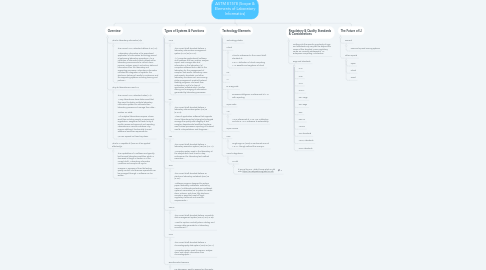
1. Overview
1.1. What is laboratory informatics (LI)?
1.1.1. The current ASTM standard defines it as (1.3): "Laboratory informatics is the specialized application of information technology aimed at optimizing laboratory operations. It is a collection of informatics tools utilized within laboratory environments to collect, store, process, analyze, report, and archive data and information from the laboratory and supporting processes. Laboratory informatics includes the integration of systems, the electronic delivery of results to customers, and the supporting systems including training and policies."
1.2. Why do laboratorians need LI?
1.2.1. The current ASTM standard notes (1.4): "Many laboratories have determined that they need to deploy multiple laboratory informatics systems to automate their laboratory process and manage their data." Section 5.5 adds: "All analytical laboratories require a basic work flow including sample or experiment registration, assignment of tests, entry of results, review and approval and reporting. Laboratories in various industries may require additional functionality to meet additional workflow requirements." We can expand on these key ideas.
1.3. What is LI capable of (how can it be applied effectively)?
1.3.1. The capabilities of LI software are typically built around laboratory workflow, which is discussed at length in section 6 of the current draft, "Laboratory Informatics Workflow and Sample Life Cycle." However, a synopsis of how lab testing, quality control, and business operations can be managed through LI software can be written.
2. Types of Systems & Functions
2.1. LIMS
2.1.1. The current draft standard defines a laboratory information management system (LIMS) as (3.2.15): "(1) computer application(s) software and hardware that can acquire, analyze, report, and manage data and information in the laboratory; (2) computer software that is used in the laboratory for the management of samples, test results, laboratory users, instruments, standards, and other laboratory functions such as invoicing, plate management, product/material stability programs, and work flow automation; and (3) a class of application software which handles storing and managing of information generated by laboratory processes."
2.2. LIS
2.2.1. The current draft standard defines a laboratory information system (LIS) as (3.2.10): "class of application software that supports clinical laboratories by helping technologists manage the quality and integrity of test samples; departmental workflow functions, result review processes, reporting of finalized results, interpretations, and diagnosis."
2.3. LES
2.3.1. The current draft standard defines a laboratory execution system (LES) as (3.2.11): "computer system used in the laboratory at the analyst work level to aid in step enforcement for laboratory test method execution."
2.4. ELN
2.4.1. The current draft standard defines an electronic laboratory notebook (ELN) as (3.2.6): "software program designed to replace paper laboratory notebooks. Defined by CENSA (Collaborative Electronic Notebook Systems Association) as 'a system to create, store, retrieve, and share fully electronic records in ways that meet all legal, regulatory, technical and scientific requirements.'"
2.5. SDMS
2.5.1. The current draft standard defines a scientific data management system (SDMS) as (3.2.20): "used to capture, centrally store, catalog, and manage data generated in a laboratory environment.'"
2.6. CDS
2.6.1. The current draft standard defines a chromatography data system (CDS) as (3.2.1): "computer system used to acquire, analyze, store, and report information from chromatographs.'"
2.7. Bioinformatic/Genomic
2.7.1. Per discussion, want to expand on this realm.
3. Technology Elements
3.1. Technology Stacks
3.2. Cloud
3.2.1. Cloud is referenced in the current draft standard at: 3.2.2 A definition of cloud computing 7.14 Benefits and negatives of cloud
3.3. IoT
3.4. AI
3.5. BI & Big Data
3.5.1. Business intelligence is referenced at 7.12 with reporting.
3.6. Open Data
3.7. API
3.7.1. API is referenced at 7.3.2.7 as a definition and at 8.5.1.5 in reference to extensibility.
3.8. Open Source
3.9. SSO
3.9.1. Single sign-on (SSO) is mentioned once at 7.5.4.1, though without the acronym.
3.10. Social Integrations
3.10.1. OAuth
3.10.1.1. If you're like me, I didn't know what OAuth was: https://en.wikipedia.org/wiki/OAuth
4. Regulatory & Quality Standards & Considerations
4.1. Getting into the specific granularity of regs and standards may very well be beyond the scope of this standard. Some regulatory issues are currently addressed in 7.5 Enterprise Computing Architecture.
4.2. Regs and Standards
4.2.1. CAP
4.2.2. CLSI
4.2.3. CLIA
4.2.4. HIPAA
4.2.5. FDA Regs
4.2.6. EPA Regs
4.2.7. GxP
4.2.8. NELAC
4.2.9. ASCLD
4.2.10. ISO Standards
4.2.11. ASTM Standards
4.2.12. NIST Standards
5. The Future of LI
5.1. General
5.1.1. New and up-and-coming systems
5.2. Other aspects
5.2.1. Open
5.2.2. Cloud
5.2.3. Social
